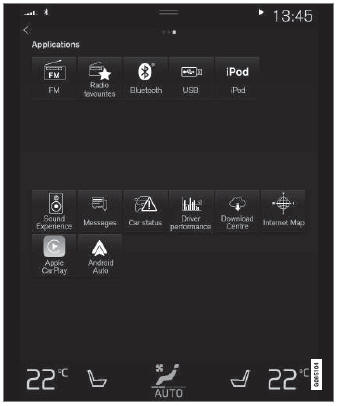Volvo XC90 2015-2025 Owners Manual / Driver support / Adaptive Cruise Control limitations
Volvo XC90: Driver support / Adaptive Cruise Control limitations
(Option/accessory.)
Adaptive Cruise Control (ACC1) may have limited functionality in certain situations.
Steep roads and/or heavy loads
Adaptive Cruise Control is primarily intended to be driven on flat roads. The function may not be able to maintain the correct time interval to the vehicle ahead when driving down steep hills. The driver should be extra attentive and prepared to apply the brakes.
Do not use Adaptive Cruise Control if the vehicle is carrying a heavy load or towing a trailer.
Drive mode unavailable
The Off Road drive mode cannot be selected if Adaptive Cruise Control is activated.
WARNING
- This is not a collision avoidance system. The driver is always responsible and must intervene if the system fails to detect a vehicle ahead.
- The function does not brake for people or animals and does not brake for small vehicles, such as bikes and motorcycles. Similarly, it does not brake for low trailers, oncoming, slow-moving or stationary vehicles and objects.
- Do not use the function in demanding situations, such as in city traffic, at intersections, on slippery surfaces, with a lot of water or slush on the road, in heavy rain/snow, in poor visibility, on winding roads, or on on/off ramps.
NOTE
The function uses the vehicle's camera and radar sensor, which has certain general limitations.
1 Adaptive Cruise Control
 Adaptive Cruise Control standby mode
Adaptive Cruise Control standby mode
(Option/accessory.)
(Depending on market, this function can be either standard or optional.)
Adaptive Cruise Control (ACC1) can be deactivated and put in standby
mode...
 Switching between cruise control and Adaptive Cruise Control in the center display
Switching between cruise control and Adaptive Cruise Control in the center display
(Option/accessory.)
(Depending on market, this function can be either standard or optional.)
When the regular cruise control (CC1) is selected in the instrument
panel, you can switch to Adaptive Cruise Control (ACC2) in the center
display's Function view...
Other information:
Volvo XC90 2015-2025 Owners Manual: Child restraints
Suitable child restraints should always be used when children travel in the vehicle. Child restraint systems Infant seat There are three main types of child restraint systems: infant seats, convertible seats and booster cushions. They are classified according to the child's age and size...
Volvo XC90 2015-2025 Owners Manual: Activating and deactivating the compass. Calibrating the compass
Activating and deactivating An integrated compass1 in the upper right corner of the rearview mirror shows the direction the vehicle is traveling. The compass is automatically activated when the vehicle is started. To deactivate/activate the compass manually: Use a paper clip or similar object to press the button on the bottom of the mirror...
Copyright © 2025 www.voxc90.com

